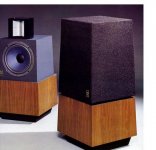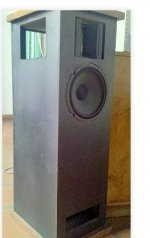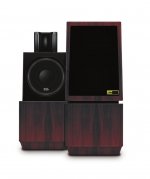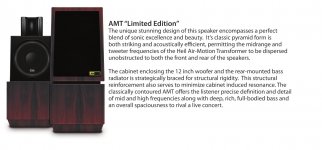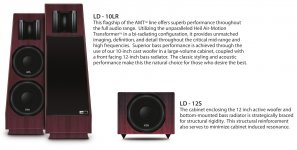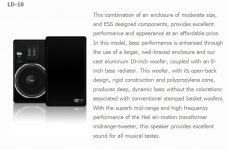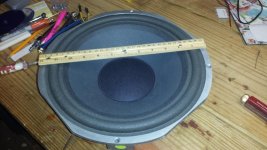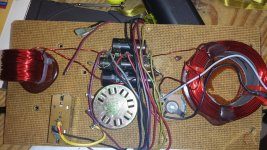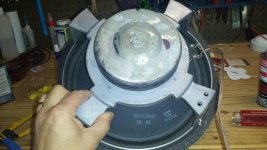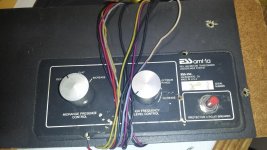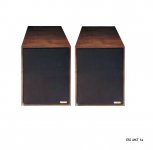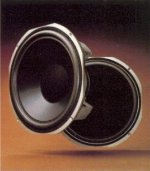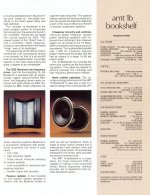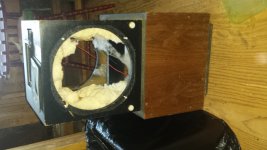I have a pair of ESS AMT 1's. The cabinets are trashed but the drivers and crossovers are great. I am thinking that a bass reflex or transmission line cabinet for the 12" bass driver and the AMT on top might produce something better than the original. I can build the boxes but can't design them.
Please show me the way.
Any thoughts or comments would be great.
Thanks in advance.
Comer
Please show me the way.
Any thoughts or comments would be great.
Thanks in advance.
Comer
So you want to build. It's only possible with the full parameters from the driver. I only have access to the standard version 12" ESS 689-1220 12" Cast with Treated and reinforced paper cone with rubber half-roll surround, Part # 264-622
ESS 689-1220 12" Cast Frame Woofer Speaker | 264-622
To design a speaker you need to have access to the T/S parameters or either measured by you, if not the same above driver.
Here the ESS amt1 (1973) with a 10" reflex.
What drivers do you have and why do you want to change (BR or other) instead of building a copy of the original enclosure?
ESS 689-1220 12" Cast Frame Woofer Speaker | 264-622
To design a speaker you need to have access to the T/S parameters or either measured by you, if not the same above driver.
Here the ESS amt1 (1973) with a 10" reflex.
What drivers do you have and why do you want to change (BR or other) instead of building a copy of the original enclosure?
the original cabinet is a truncated obelisk and hard to build - the woofer you mention is the replacement for the ones that I have and - so I am assuming they are close - the original speaker is known to be lacking in bass - i figured a new cabinet may improve that
( fs = 24, Qes=4.9, Qes = .52, Qts , .47, Vas = 6.69, )
also read that the ESS AMT 1 Tower was a transmission line with same componeants and hard to beat - but I cant find the design
thanks for helping out
( fs = 24, Qes=4.9, Qes = .52, Qts , .47, Vas = 6.69, )
also read that the ESS AMT 1 Tower was a transmission line with same componeants and hard to beat - but I cant find the design
thanks for helping out
You see, in changing the alignment (LF) you will change the output level and Q for the crossover what may or may not change the flat response of the speaker.
The parameters that you give (I have them alrady) are from the PE driver not from yours. Usually we say here in the forum, that there are not 2 drivers that measure the same or are the same, and never a replacement in this case. But if you insist. I can give you an alignment for that driver, with very good extension, then what, you can't reproduce it with your driver/speaker/system, they are not the same drivers.
Now, if you are buying those new drivers that would be a different situation.
The parameters that you give (I have them alrady) are from the PE driver not from yours. Usually we say here in the forum, that there are not 2 drivers that measure the same or are the same, and never a replacement in this case. But if you insist. I can give you an alignment for that driver, with very good extension, then what, you can't reproduce it with your driver/speaker/system, they are not the same drivers.
Now, if you are buying those new drivers that would be a different situation.
OK
So here is the problem - I have these drivers and these crossovers and trashed cabinets - I can't replicate the cabinets like the originals but I can make some more traditional boxes. What should I do.
Thanks again for your time!!
So here is the problem - I have these drivers and these crossovers and trashed cabinets - I can't replicate the cabinets like the originals but I can make some more traditional boxes. What should I do.
Thanks again for your time!!
Will take a photo of the 12" when I get home - I don't have testing equipment I just figured the replacement specs would be approximate
Yes. That's a very close to the original duplicate that would be enough.OK
So here is the problem - I have these drivers and these crossovers and trashed cabinets - I can't replicate the cabinets like the originals but I can make some more traditional boxes. What should I do.
Thanks again for your time!!
We need to know if the speaker is sealed, reflex or other like (TL) transmission line.
If sealed is fine but if other like a reflex we need the exact dimensions/thickness/material for the port/tube and location inside the cabinet for reference. Can you access the model/year(?) generally in the back panel.
Then after that, we need the volume (net) internal. There are many ways of doing that including measuring the/all the panels you have. If measuring the outside dimensions we also need thickness of ply/mdf. That's useful if building new ones, to know the type or thickness of the material that they used before. 🙂
Yes, approximate... but not the same. They will be the same (or approximate) if the model/driver is from the same batch/year and measured to follow the same specs in the factory, than that that you see in Parts Express or another shelf/stock. Meaning that they were made at the same time (window/year) or to the same specs as an old stock. 😉Will take a photo of the 12" when I get home - I don't have testing equipment I just figured the replacement specs would be approximate
The same drivers (same model year, so to say) are different within a margin that is set like 10% (or 5%) from the target. They are production deviations following a quality control. If the parameters change for a second model/year then you don't have the same driver anymore. 😀
ESS continued
so - I have attached a before and after - the after is labeled "tower". I have naively assumed that I can use the 'guts' from the essamt1 (before) and build a pair of speakers configured like the more traditional tower in the photo. I am hoping that with the thiel parameters a larger cabinet might be designed that would improve the bass lacking in the original. I have used some simple web page calculator and the parameters from Parts
Express and come up with a sealed cabinet with a volume of 5.3 feet which is manageable. The calculator yielded a ported cabinet with a volume of 11 feet ++ which is too big. The Tower which was actually for sale by ESS in the 70's was a transmission line and rumored to have produced fabulous results.
I guess I can measure one of the old cabinets but I was (maybe naively ) hoping to improve on that..
thanks again
so - I have attached a before and after - the after is labeled "tower". I have naively assumed that I can use the 'guts' from the essamt1 (before) and build a pair of speakers configured like the more traditional tower in the photo. I am hoping that with the thiel parameters a larger cabinet might be designed that would improve the bass lacking in the original. I have used some simple web page calculator and the parameters from Parts
Express and come up with a sealed cabinet with a volume of 5.3 feet which is manageable. The calculator yielded a ported cabinet with a volume of 11 feet ++ which is too big. The Tower which was actually for sale by ESS in the 70's was a transmission line and rumored to have produced fabulous results.
I guess I can measure one of the old cabinets but I was (maybe naively ) hoping to improve on that..
thanks again
Attachments
inductor
on another topic - I just clicked your link to the William Ralston Listen Library - I am floored - do you have a connection to Sewanee
on another topic - I just clicked your link to the William Ralston Listen Library - I am floored - do you have a connection to Sewanee
Yeah (no I don't), when people do stop making wars against each other and start giving value to what they have in life... maybe they will appreciate music better. 🙂inductor
on another topic - I just clicked your link to the William Ralston Listen Library - I am floored - do you have a connection to Sewanee
(In this post we are attempting to ask the OP about the dimensions for the main driver (and speaker) that he owns and that is not well documented.)
Those are not ESS AMT-1 you have, the ESS AMT-1's model have 10" drivers (as I said before).
You say ""I have 12" drivers", then you must have ESS AMT-1b. The ones in the picture are not 12" drivers at least not in the first picture (10" driver in pic#1) , and the second from your speaker doesn't look like a 12" either (it's easy to measure).
The speakers with the 12" drivers are the ESS AMT-1b floor-standing or bookshelf and they have a second passive radiator (PR) technology not a transmission line. But I can not be sure of this until I see one. First I want to make sure of this, regarding that you might have a lost case between hands, if not measuring and simulating your drivers for the new enclosure. 😀
The ESS AMT-1b and ESS AMT-1e (more recent) both have 12" drivers.
Changing shifts to the ESS AMT-1b floor-standing with 12" drivers and passive radiators.
ESS amt-1b Speaker with Cover Removed | Mike's Vintage Stereo Equipment
stereonomono: ESS amt-1b
ESS AMT 1B Floorstanding Speakers reviews - Audioreview.com
If possible describe also the material you have for the surround of the drivers (rubber, other).
What crossover do you have, original(?), to what model?
1. ESS AMT “Limited Edition”: 12" driver + 12" passive radiator (PR) (back)
2. ESS LD - 10LR: 10" driver + 12" passive radiator (PR) (front)
3. ESS LD Sub - 12S: 12" driver + (?) passive radiator (PR) (bottom)
4. ESS LD-10: 10" driver + 8" passive radiator (PR) (back)
ESS Laboratories USA
pdf (2011/2014)
Attachments
sorry - was not able to get photos last night - the drivers are clearly 12" and recently had them re-foamed - parts express did it - sent the crossover to ess in California to be refurbished - which they did- can get photo of that too
that listening room is at the University of the South - often referred to as Sewanee. Fine liberal arts school located in Tennessee several hours north of Atlanta, GA USA where I live - I have called the professor in the video that manages it and plan to go visit in the next few months
that listening room is at the University of the South - often referred to as Sewanee. Fine liberal arts school located in Tennessee several hours north of Atlanta, GA USA where I live - I have called the professor in the video that manages it and plan to go visit in the next few months
What great plans you have. 😀
Great news, you have the 12". So it's not from the ESS AMT-1, but from a model similar to the ESS AMT-1b/ESS AMT-1e or any other (posterior?) that I'm not aware of.
What material was used in the new surrounds, foam/originals or more recent rubber ones?
They didn't measure the T/S parameters did they?! 🙂
Great news, you have the 12". So it's not from the ESS AMT-1, but from a model similar to the ESS AMT-1b/ESS AMT-1e or any other (posterior?) that I'm not aware of.
What material was used in the new surrounds, foam/originals or more recent rubber ones?
They didn't measure the T/S parameters did they?! 🙂
ESS continued 2
ok - here are the photos - btw both woofers are solid at 4 ohms - one tweeter is 3.7ohms and the other is 3.5
the crossover claims that they are ESS AMT 1a's - they did have the passive radiators - I dont have them
I am tempted to try to restore the old cabinets and buy new passive radiators which I don't have - I just like the idea of "repurpose and improve' rather than restore.
Thanks
ok - here are the photos - btw both woofers are solid at 4 ohms - one tweeter is 3.7ohms and the other is 3.5
the crossover claims that they are ESS AMT 1a's - they did have the passive radiators - I dont have them
I am tempted to try to restore the old cabinets and buy new passive radiators which I don't have - I just like the idea of "repurpose and improve' rather than restore.
Thanks
Attachments
ESS AMT 1a
ESS AMT 1a | Owners/Service Manuals, Schematics, Free Download, Reviews | HiFi Engine
Specifications
Type: 2 way, 2 driver loudspeaker system
Frequency Response: 50Hz to 20kHz
Power Handling: 350W
Recommended Amplifier: 75W (minimum)
Crossover Frequency: 850Hz
Impedance: 4Ω
Sensitivity: 82dB
Bass: 12" cone
Tweeter: heil air motion transformer
Grille: brown
Finish: walnut veneer
Dimensions: 610 x 356 x 356mm
Weight: 27.27kg
(Note: some models where later introduced with crossover frequency of 1,000 Hz to protect the tweeter.)
ESS AMT 1a | Owners/Service Manuals, Schematics, Free Download, Reviews | HiFi Engine
There is only one compact system with a full-size Heil. The ESS AMT 1A Bookshelf system.
Specifications
Type: 2 way, 2 driver loudspeaker system
Frequency Response: 50Hz to 20kHz
Power Handling: 350W
Recommended Amplifier: 75W (minimum)
Crossover Frequency: 850Hz
Impedance: 4Ω
Sensitivity: 82dB
Bass: 12" cone
Tweeter: heil air motion transformer
Grille: brown
Finish: walnut veneer
Dimensions: 610 x 356 x 356mm
Weight: 27.27kg
(Note: some models where later introduced with crossover frequency of 1,000 Hz to protect the tweeter.)

Attachments
ESS AMT 1b (Stand/Bookshelf or Floorstanding)
The later "b" speakers with the same dimensions as the previous "a" speaker, but now, with the squircle* 12" "BBC" bextrene/polystyrene cones and the 12" passive radiators in the back.
Crossing frequency is now 1,000 Hz with a 18 dB per octave slope for the tweeter.
Low Frequency Driver
Nominal Diameter: 12" (30,48 cm)
Cone Materials: Bextrene
Voice Coil: 2" (5,08 cm) Copper bonded with high temperature epoxy to an aluminum former
Magnetic Assembly Weight: 7 lbs. 6,5 oz. (3,36 kg)
Flux Density: 10,500 Gauss
Insulation: Single polythermaleze
Passive Radiator
Nominal Diameter: 12" (30,48 cm)
Diaphragm Material: .5 in rigid EPS styrene foam base material laminated to a damping skin of 250" open cell foam . Unitary free air resonance: 5 Hz
Notice in the link1 above the measurement of one speaker (model?) with F3 close to 40/45 Hz.
Another link2 for speaker "b". Front baffle with bextrene/poly driver and back with the passive radiator, both 12".
ESS amt1b (Floorstanding)
*) by Zilch (1942-2011 RIP)
- 10" or 12"?
- Round or squircle?
- Passives or ports?
AudioKarma.org Home Audio Stereo Discussion Forums - View Single Post - Replacement woofers for ESS Heil Amt1?
The later "b" speakers with the same dimensions as the previous "a" speaker, but now, with the squircle* 12" "BBC" bextrene/polystyrene cones and the 12" passive radiators in the back.
Crossing frequency is now 1,000 Hz with a 18 dB per octave slope for the tweeter.

Low Frequency Driver
Nominal Diameter: 12" (30,48 cm)
Cone Materials: Bextrene
Voice Coil: 2" (5,08 cm) Copper bonded with high temperature epoxy to an aluminum former
Magnetic Assembly Weight: 7 lbs. 6,5 oz. (3,36 kg)
Flux Density: 10,500 Gauss
Insulation: Single polythermaleze
Passive Radiator
Nominal Diameter: 12" (30,48 cm)
Diaphragm Material: .5 in rigid EPS styrene foam base material laminated to a damping skin of 250" open cell foam . Unitary free air resonance: 5 Hz
The ESS Bextrene low frequency driver
Like the floor-standing 1b, the Bookshelf is equipped with an exceptionally rugged vacum-formed Bextrene low frequency driver newly improved and built entirely by ESS. Developed by BBC studio engineers for studio reference systems. Bextrene is a polystyrene compound with exceptional properties not found in pulp cones:
Low mass. High structural rigidity. Great internal molecular damping for superb quieting. Less susceptible to resonance and masking distortion. Greater clarity and accuracy.
Passive radiator
A rear-mounted 12" passive radiator operates in tandem with the Bextrene woofer to augment bass response. The passive radiator serves the same purpose as a port, but avoids the distortion added by a port or the loss of efficiency inherent in acoustic suspension systems.
Crossover circuitry and controls
Improved phase response, greater power handling capability and improved driver damping in the crossover region are all results of the 1b Bookshelf's completely new frequency dividing network. This sophisticated parallel type 1,000 Hz crossover assures proper matching of the woofer with the Heil by means of a steep 18 dB per octave slope.
The amt-1b Bookshelf now includes the same dual controls as the floor-standing system. They allow the listener to achieve precisely the midrange and high frequency performance desired.
stereonomono: ESS
Notice in the link1 above the measurement of one speaker (model?) with F3 close to 40/45 Hz.
Another link2 for speaker "b". Front baffle with bextrene/poly driver and back with the passive radiator, both 12".
ESS amt1b (Floorstanding)
*) by Zilch (1942-2011 RIP)
- 10" or 12"?
- Round or squircle?
- Passives or ports?
AudioKarma.org Home Audio Stereo Discussion Forums - View Single Post - Replacement woofers for ESS Heil Amt1?
Attachments
I see lots of confusion
OK, first models -
The ESS AMT-1 used a 10" paper cone woofer, ported enclosure, and a boxy version of the AMT. Nelson Pass had something to do with this one. The peakes in the 10" woofer worked to cancel some response drop off of the Heil, and the net result bordered on listenable.. Perhaps my favorite version, for background music anyway.
ESS AMT-1A, 12" paper type woofer, a passive radiator, and the AMT has a notched top, as they remain to this day.
ESS AMT-1B, still 12" woofer, but now bextrene(ha!) and a somewhat more sophisticated crossover - I was told that Von Schweikert did the crossover work for these and perhaps the 1C.
ESS AMT-1C, now polypropylene is supposedly used for the 12" woofer, however ESS seemed to use several different 12" cones starting with this model. We saw two shipped together, and they had different woofer materials.
ESS AMT 1-D, more of the same, etc. etc. The AMT's went to Kapton type film for awhile, then back to mylar. Also, the plate design went to a more open but rather funky looking design for the AMT's. There was an ESS AMT-II(10" woofer, and a passive radiator, truncated pyramid shape) that used this version. Then, back again to the small plates for the Heil.
In between you had the ESS AMT-1 tower, transmission line cabinet, by far the best bass imo. The ESS AMT monitor using 2 12", Versions using 1 12" and a 12" passive in front, and again, etc., etc. The "rock monitor", the Professional model with multiple ess AMT drivers arranged in a horn looking configuration, and many other models.
The real problems with all of these were -
The Heil drivers are flawed. They are anything but "flat" in response, although to this day, the deaf among us don't believe it. All accurately/professionally done response plots of this driver show a very large peak of some 6 to 9 db(depending on model and who did the testing) in the 6 kHz. to 9 kHz region. This was compounded by the rolloff due to dipole cancellation as it went down in frequency. These effects can be addressed with today's crossover optimization programs, but such were not available back when these were being made. The result is a profoundly rising response from about 1.5 kHz to the around 14 kHz or so, when in fact the response begins to dive. They really don't make good "super tweeters" even though you can somewhat boost the extreme highs. It's that rising response curve that is initially so impressive, and that for many(myself very much included) leads to listener fatigue. Other people just LOVE THEM and are determined to believe this is just a better defined tweeter than the flat response, lower distortion tweeters used in most high end systems.. To each, his own.
Also, a 12" woofer is simply a poor choice for a 2-way system. A few drivers can do this, Tannoy comes to mind, but NOT the woofers used by ESS.
Google for "Heil Heavens" and you'll see a system designed by Dennis Murphy( a terrific designer, a musician and an overall wonderful guy!) for an acquaintance of mine, and built by Salk Audio. Dennis managed to massage the Heils response and optimize it's integration with a 8" woofer, in his preferred mass loaded ported enclosure design. F3 of around 30 HZ from a 8" 2-way! Still, looking at the finished response curve, it is not quite as smooth as I'd like to see it for a speaker that was built for many thousands of dollars, but...it was the best that could be done with that particular driver. Overall, the response looks decent, and Salk did a GREAT job on the finished appearance.
I'm told though that the speakers sound quite nice. I may stop in and give them a listen when I get out that way.
Anyway, my suggestions -
Forget the 2 way with the 12" woofer. I note that Rick C. of ESS is still insisting on mating the Heil to 12" woofers.....oh well, lead a horse to water, etc....
Nelson Pass, Von Schweikert and other notable audio designers have tried to get ESS to use mating woofers and bass systems that make better sense in the years they worked with ESS, but they always left in frustration.
So, either go 3-way, or completely change out the woofer to something with a smaller diameter, low distortion, and wide bandwidth, AND regardless of what you decide to do; invest in modeling software as well as testing hardware. Some good freeware programs are available to test and design different bass enclosures, as well as confirm the modeled crossover response when used with a calibrated microphone. It won't be easy but you may end up with something very nice, as well as unique.
OK, first models -
The ESS AMT-1 used a 10" paper cone woofer, ported enclosure, and a boxy version of the AMT. Nelson Pass had something to do with this one. The peakes in the 10" woofer worked to cancel some response drop off of the Heil, and the net result bordered on listenable.. Perhaps my favorite version, for background music anyway.
ESS AMT-1A, 12" paper type woofer, a passive radiator, and the AMT has a notched top, as they remain to this day.
ESS AMT-1B, still 12" woofer, but now bextrene(ha!) and a somewhat more sophisticated crossover - I was told that Von Schweikert did the crossover work for these and perhaps the 1C.
ESS AMT-1C, now polypropylene is supposedly used for the 12" woofer, however ESS seemed to use several different 12" cones starting with this model. We saw two shipped together, and they had different woofer materials.
ESS AMT 1-D, more of the same, etc. etc. The AMT's went to Kapton type film for awhile, then back to mylar. Also, the plate design went to a more open but rather funky looking design for the AMT's. There was an ESS AMT-II(10" woofer, and a passive radiator, truncated pyramid shape) that used this version. Then, back again to the small plates for the Heil.
In between you had the ESS AMT-1 tower, transmission line cabinet, by far the best bass imo. The ESS AMT monitor using 2 12", Versions using 1 12" and a 12" passive in front, and again, etc., etc. The "rock monitor", the Professional model with multiple ess AMT drivers arranged in a horn looking configuration, and many other models.
The real problems with all of these were -
The Heil drivers are flawed. They are anything but "flat" in response, although to this day, the deaf among us don't believe it. All accurately/professionally done response plots of this driver show a very large peak of some 6 to 9 db(depending on model and who did the testing) in the 6 kHz. to 9 kHz region. This was compounded by the rolloff due to dipole cancellation as it went down in frequency. These effects can be addressed with today's crossover optimization programs, but such were not available back when these were being made. The result is a profoundly rising response from about 1.5 kHz to the around 14 kHz or so, when in fact the response begins to dive. They really don't make good "super tweeters" even though you can somewhat boost the extreme highs. It's that rising response curve that is initially so impressive, and that for many(myself very much included) leads to listener fatigue. Other people just LOVE THEM and are determined to believe this is just a better defined tweeter than the flat response, lower distortion tweeters used in most high end systems.. To each, his own.
Also, a 12" woofer is simply a poor choice for a 2-way system. A few drivers can do this, Tannoy comes to mind, but NOT the woofers used by ESS.
Google for "Heil Heavens" and you'll see a system designed by Dennis Murphy( a terrific designer, a musician and an overall wonderful guy!) for an acquaintance of mine, and built by Salk Audio. Dennis managed to massage the Heils response and optimize it's integration with a 8" woofer, in his preferred mass loaded ported enclosure design. F3 of around 30 HZ from a 8" 2-way! Still, looking at the finished response curve, it is not quite as smooth as I'd like to see it for a speaker that was built for many thousands of dollars, but...it was the best that could be done with that particular driver. Overall, the response looks decent, and Salk did a GREAT job on the finished appearance.
I'm told though that the speakers sound quite nice. I may stop in and give them a listen when I get out that way.
Anyway, my suggestions -
Forget the 2 way with the 12" woofer. I note that Rick C. of ESS is still insisting on mating the Heil to 12" woofers.....oh well, lead a horse to water, etc....
Nelson Pass, Von Schweikert and other notable audio designers have tried to get ESS to use mating woofers and bass systems that make better sense in the years they worked with ESS, but they always left in frustration.
So, either go 3-way, or completely change out the woofer to something with a smaller diameter, low distortion, and wide bandwidth, AND regardless of what you decide to do; invest in modeling software as well as testing hardware. Some good freeware programs are available to test and design different bass enclosures, as well as confirm the modeled crossover response when used with a calibrated microphone. It won't be easy but you may end up with something very nice, as well as unique.
I notice as of 2016 Elac, Martin-Logan, and Golden Ear all have highly rated speakers using Heil type tweeters. Does this mean the problems you site aren't necessarily inherent in the Heil concept, but rather as implemented in the famous large ESS Heil driver?
- Status
- Not open for further replies.
- Home
- Loudspeakers
- Multi-Way
- DIY ESS Amt 1 Tower Project
